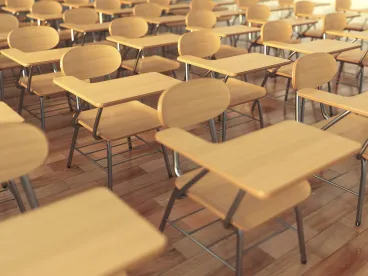Even though polychlorinated biphenyls (PCBs) have not been manufactured in the U.S. for over forty years, they continue to be present in building materials, including in caulk and joint materials, paint, siding, roofing, and light ballasts. PCBs are more common in structures built or renovated between 1950 and 1980. The ongoing presence of PCBs can create risks for building owners and material manufacturers. To mitigate those risks, it is important to identify, remove, and properly dispose of building materials containing PCBs.
Litigation Risks
The current wave of litigation on PCBs in building materials is focused on schools. A jury in Washington State recently awarded $185 million to three teachers who claimed that PCBs in fluorescent light ballasts caused them brain damage. These plaintiffs are just the first of about 200 in the case. In 2016, a judge in California ordered the Santa Monica-Malibu school district to remove all PCBs from two schools by 2019. The recent high-dollar verdict in Washington will likely embolden additional plaintiffs to bring similar suits.
The Toxic Substances Control Act (TSCA) governs the use and disposal of PCBs. Under TSCA, any building material containing at least 50 parts per million (ppm) of PCBs is considered a “prohibited use,” and should be removed.
The Comprehensive Environmental Response, Compensation, and Liability Act (CERCLA) and its state analogues impose strict liability on owners and operators of facilities that released hazardous substances or arranged for their disposal. In the building materials context, this can mean liability for owners and operators of buildings where PCBs from building materials were released into soil, groundwater, or stormwater. It can also mean potential liability for parties that dispose of PCB-contaminated material during building renovations and demolition. PCB removal projects are complex and involve close regulatory oversight.[i]
Best Practices
1. Identification of PCB-Containing Building Materials
While building owners and operators are not required to test building materials for PCBs if they are not being disturbed or disposed of, owners and operators may voluntarily test building materials they suspect contain PCBs. If owners or operators decide to test voluntarily, testing indoor air, getting wipe samples from building surfaces, reviewing building records, and compiling an inventory of materials that may contain PCBs can help the building owner or operator narrow down testing locations. Any sampling plan should take into account current and future plans for the building and project remediation goals. Rather than test, a building owner or operator can also assume all of the suspected manufactured PCB products contain greater than 50 parts per million (ppm).
EPA recommends that owners or operators prioritize removal of PCB-containing material by considering the concentrations of the PCBs, the condition of the PCB-containing material (for example, if caulk is cracking or peeling), the accessibility of the materials to building occupants, and whether the PCB-containing materials are in areas with higher occupancy. In particular, caulk can contain up to 50% PCBs and even caulk in lower concentrations can pose problems if it is peeling, brittle, or cracking.
2. Planning
PCBs are most likely to be released from a building during demotion or renovation, so it is particularly important to test materials for PCBs when planning a demolition or renovation. Identifying materials containing PCBs prior to beginning work will help construction owners and operators determine whether they need to expand the scope of work for the renovation to include disposal of PCB waste.
A party planning to remove PCB-containing building material may need to obtain approval from EPA prior to starting the project, and should complete an abatement plan for removal, disposal, and additional sampling. Operators and owners should consider controls to prevent releases of PCBs into surrounding stormwater and surface water conveyances, and such controls may be required if the construction activity is permitted under the Clean Water Act.
3. Disposal
If the building owner-operator finds PCBs in concentrations greater than 50 ppm or assumes they are present, the building materials must be removed for disposal as PCB bulk product waste. If an owner or operator finds PCB-containing materials, they should also determine if PCBs have migrated from the original PCB-containing material into surrounding porous substrates such as brick or concrete. These substrates, if contaminated, will need to be disposed of as PCB remediation waste, unless they are still attached to the PCB-contaminated material, in which case both the material and the substrate should be disposed of as bulk product waste.
Anyone storing, transporting, or disposing of PCBs must notify EPA. EPA will, in turn, issue an EPA identification number. Maintaining waste manifests and other records of disposal is an important component of TSCA compliance. A party may also need to complete an abatement report and maintain it on file for three to five years.
Resources and Draft Guidance
EPA and the Washington Department of Ecology have both recently issued fact sheets on PCBs in Building Materials. EPA encourages people to contact the Regional PCB Coordinator in their area for more information on how to properly address PCBs.
For property owners and operators in Washington, Ecology is currently drafting guidance on PCBs in building materials, which Ecology plans to publish by December 2022. This guidance will help with identification and characterization of PCBs in building materials, proper handling of PCB sources during demolition and renovation, understanding the potential costs associated with demolition and renovation, and understanding TSCA and Washington state regulatory requirements related to PCBs in Building Materials.
[i] The Rainier Commons (old Rainier Brewery) is illustrative of the complexity of a PCB abatement project. Some PCB paint with concentrations above 50 ppm was identified. The work plan for the project outlines plans for removal of paint and coordination with both EPA and building tenants.







 />i
/>i
